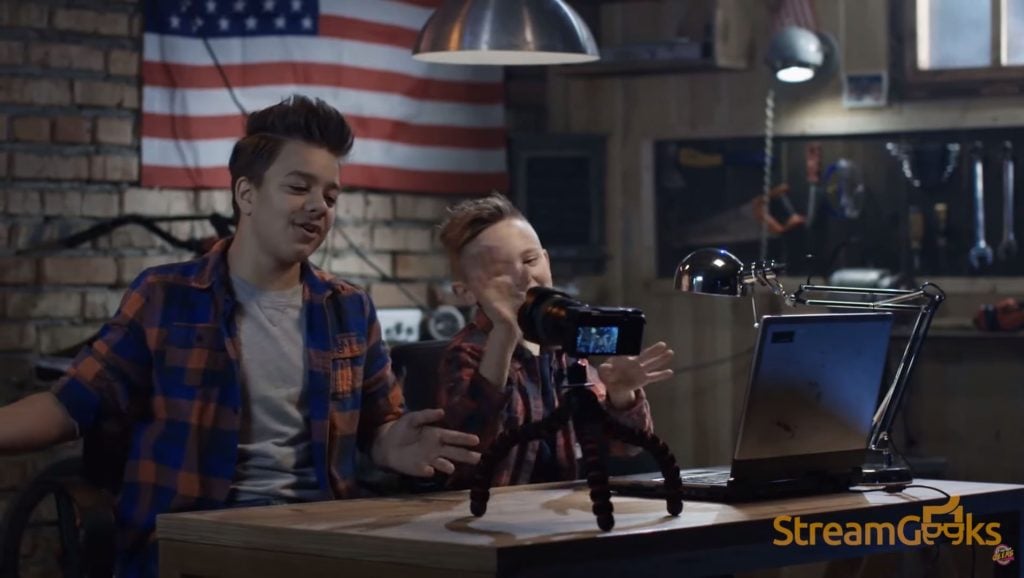Broadcast Club Case Study: Griswald High School
Written by Paul Richards on April 29, 2019
How the Griswold High School Uses vMix to Produce The Morning Announcements
I have seen a lot of vMix systems in my career and the Griswold High School morning announcements system is one that makes me smile just thinking about it. The school has managed to involve over 10 real-time student-run operational roles.
Throughout the production of their morning announcements show, the club is using three vMix licenses all run on separate computers. Leveraging the power of the schools Local Area Network (LAN), the club is able to connect four computers together into a single video production environment. We will cover networking in an upcoming chapter, but for now, just understand that each computer is connected together and therefore able to interact with each other and share resources.
The graphic above illustrates the major parts of the video production system. The main computer is running vMix and is controlled by the technical director using a keyboard and mouse. This computer has all three camera sources and the audio mixer connected to it. The second computer is used to display the weathers man’s slides for the day. Using a camera with a green screen, the main vMix computer is able to chroma key the weather man’s background. A chroma key is a video production process for removing a certain color from a video feed to make that color transparent. The video camera feed for the weatherman can then be layered on top of the PowerPoint slides coming in from computer two. In this way, the school can present the weather just like you see on TV.
The weatherman has a wireless PowerPoint remote control that is used to advance the slides from the dedicated computer running PowerPoint. This computer is running a piece of software called the vMix Desktop Capture App which is able to send the full screen of video directly into the main vMix computer for the technical director to use over the network. You can see the “Confidence” monitors which are in place to show the weatherman what he looks like on camera with his PowerPoint slides behind him. This allows the weatherman to see exactly what he is talking about while remaining focused on his delivery to the camera. If this sounds a bit too technical, or a lot all at once, don’t worry. The online training course is going to review this in detail using the same exact software used here.
A third computer is used as a character generator. This computer uses the vMix Web Controller to allow the graphics chief to update titles inside vMix and overlay graphics directly onto the broadcast when they are needed. The vMix Web Controller interface is a compact version of the actual vMix interface which is accessible to any computer on your LAN (Local Area Network). This means that you can use any computer with a web-browser on your LAN to control vMix. We will discuss more about local area networks and IP connectivity in a dedicated chapter towards the end of this book.
The vMix web interface has 4 different areas: shortcuts, controller, tally lights, and titles. These can be changed by clicking the icons along the top. For the graphics chief, they are only concerned with titles and shortcuts. The graphics chief can open up two google chrome web-browsers and split the screen 50/50 to have access to both at the same time. On the titles screen, the graphics chief will see all the titles that are currently in the vMix production on the main computer. From here the operator can quickly edit and change these titles before they are shown on screen
The shortcuts screen will automatically show all shortcuts that have been set up on the main vMix machine. A shortcut is a trigger that can be designed to perform almost any video production task in the software. This allows the club to give the graphics chief access to specific buttons that can trigger almost any action including fading to the opening video, overlaying graphics, and initiating the closing credits. In the picture above, you can see the shortcut buttons available on the left-hand side of the screen. These include opening, birthdays, lower third, credits and word of the day.
The word of the day is an interesting portion of the show where the club leverages website data to produce up to date information each day. The club uses vMix’s “Web Browser” video input to display this information by entering in the address to the Dictionary.com’s word of the day website (https://www.dictionary.com/wordoftheday). Because this webpage is updated every day, the input will always have a new word displayed in its title each day. So, when it comes time to display the word of the day, the graphics chief only needs to click the shortcut button that has been configured to overlay a cropped portion of this webpage onto the screen. The teleprompter chief will check this word and make sure it is included in the script for the on-air talent. The on-air talent will, in turn, make sure they understand the correct pronunciation before the show.
The school birthday title is a ticker that can be updated with information that scrolls across the bottom of the screen. Tickers are used quite commonly in television production to provide additional information in a non-obtrusive way. The graphics chief can quickly update this information inside the titles section of their web controller. If there is a birthday that they need to display in this ticker, they can use the shortcut button to trigger the overlay on and off the broadcast as needed.
Inside vMix, each camera input looks like a square. Each square has a number which corresponds to its position in the production. When the technical director clicks one of these squares, that input is put into the preview window by default. This preview window is the area that the technical director uses to queue up the next upcoming video input for the production. When the technical director is ready to transition to this video input, they can click one of the transition options which are conveniently available directly in between the preview and output screens. vMix also features four layers of overlays and 10 layers of multiview flexibility. With the four layers of overlays, the graphics chief can overlay up to four items on top of the base video layer that the technical director has in the output screen. This is ideal for quickly overlaying lower thirds or ticker titles that may come and go as the technical director switches between the main video sources. Multiview layers work inside each individual input. Using multiview layers the technical director can have a single input setup with multiple layers attached by default into a new composition. The broadcast club does this nicely with the weatherman input. This input is essentially two inputs layered together into one. Using this method, the technical director has just one input to transition to that is built out of the weatherman PowerPoint slides with the chroma keyed video layered on top. Other important buttons that you will learn about in our online course include the record button, the stream button, and the full-screen button.
The technical director has a total of 15 inputs inside vMix. The graphics chief controls five of these inputs and the other 10 have been organized into a production workflow for morning announcements. Here are the inputs:
1-4: Camera placeholders (makes shortcuts easier to manage)
5-7: Camera inputs (HDMI internal card, external dual HDMI capture)
8: Opening graphics (Graphics Chief)
9: Virtual camera input with chroma key enabled
10: Credits (Graphics Chief)
11: Birthday Ticker (Graphics Chief)
12: Lower Third (Graphics Chief)
13: NDI in from Weatherman PowerPoint Slides (Weather)
14: Web Browser – (input from dictionary.com cropped for word of the day) (Graphics Chief)
15: Audio Line In
It’s really quite incredible what can be done with this type of network connected video production software. This level of video production quality used to cost hundreds of thousands of dollars and therefore was out of reach of most broadcast clubs. Most traditional video production switchers have a centralized control system. This type of centralized control has traditionally made it difficult to have multiple people working together. Now school broadcast clubs can build out systems that can integrate teams of students with independent roles working together on a single broadcast simultaneously.
Further Learning: vMix Master Class – https://www.udemy.com/vmix-live-streaming/learn/v4/











